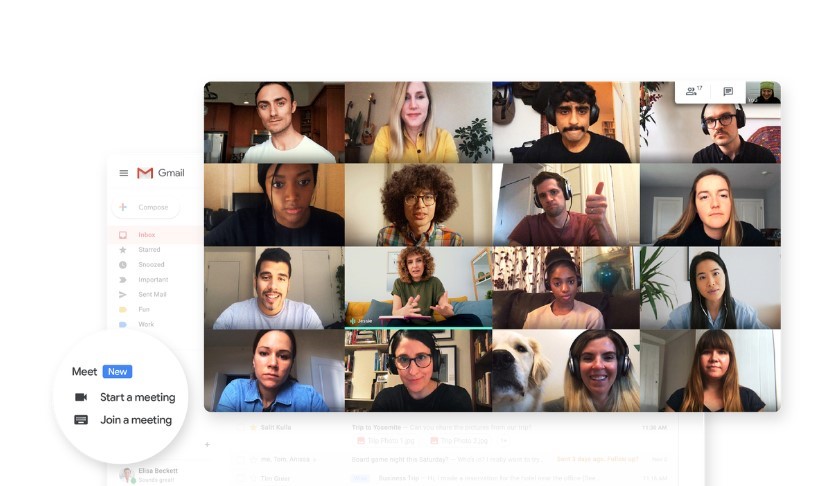Google Meet now has business-grade audio and video and enhanced controls.
May 13, 2020

Meet the new Google Meet. It’s not the same as the old Google Hangouts Meet.
The revamped Google Meet, rolling out this week with new business-grade capabilities, is primed to challenge Zoom Meetings. Google has addressed many limitations of its meeting and videoconferencing service, now free for anyone to use through Sept. 30.
Use of Google Meet has surged since early March when the COVID-19 crisis started accelerating, the company said. As the global pandemic unfolded, Google expanded the service by allowing up to 250 video meeting participants. Google also extended streaming allowance up to 100,000 viewers. But Google Meet still lacked many appealing features that Zoom offers, which also expand the scope of its free version.
Google Meet now has a tiled gallery view with a layout that now supports 16 participants, up from just four. Also, meeting participants can now adjust the layout. They can also now select higher quality video by switching to the 30 frames per-second video mode option.
Other additions include a new low-light mode that will adjust to those in darker rooms, and real-time captioning. A new noise cancelling option aims to reduce interruptions and filter background sounds including barking dogs or talking people.
Google Meet also has a new screen-sharing feature, which implements the company’s BeyondCorp Remote Access service. BeyondCorp implements zero-trust security based on technology Google has used internally for more than a decade. The free Google Meet offering allows meetings that last up to one hour.
“Because video meetings have never been more important, we’ve been fast-tracking the most requested features for Meet, and are now making them available to all,” wrote G Suite VP and GM Javier Soltero in a blog.
Staggering Growth
Use of Google Meet has grown 30 times since adding its premium features to the free offering, Soltero noted. In April, Google was adding 3 million users daily, up from 2 million the company reported earlier in the month. Google said it now hosts an average of 3 billion minutes of video meetings each day.
“That’s why we’re expanding the offering to more people around the world,” Soltero noted.
Launched in 2017 as Hangouts Meet, it added a videoconferencing extension of the Google Hangouts chat and voice communications tool. It has maintained a strong following among students and for consumers. Google has said it will offer Hangouts components as separate consumer services, such as Chat, Messages and Duo.
To date, Zoom, Microsoft Teams and Cisco Webex have overshadowed Google Meet and its predecessor brands, among businesses and organizations.
A Partner’s Take
Indeed, partners have waited for some time for Google to up the ante with Google Meet.

SADA Systems’ Tony Safoian
“It’s amazing, and about time,” said Tony Safoian, CEO of Google Cloud, G Suite and Chrome Enterprise partner SADA Systems. “We’re seeing lots of interest and traction, even though I think Google had a ‘late start’ and lots of historic confusion around messaging apps in general, which they recently finally consolidated under Javier Soltero.”
Google recruited Soltero from Microsoft last fall to lead G Suite. Soltero, who sold his mobile messaging company Acompli to Microsoft in late 2014, had led the company’s Outlook engineering team.
Nevertheless, it remains to be seen how much share Google Meet will gain among its rivals with these upgrades. The market for online meeting and videoconferencing services was already crowded before COVID-19. As it appears more people will work remotely from home indefinitely, all players are rushing to extend their respective offerings.
However, just as Microsoft Teams is now a focal tool with Office, Google needs to …
… have a viable online meeting, calling and videoconferencing solution for G Suite.
Google claims 120 million students and teachers use G Suite, along with 6 million businesses and organizations.
“Meet is easy, secure, and available to everyone — and for enterprises, they can use Google Meet with enterprise features now free until the end of September with no cost implementation from partners like SADA,” Safoian said.
A quick look shows a product that is easy to use and navigate, with reasonable video quality.
Security Front and Center
Google has emphasized security protections and policies to ensure unauthorized attendees can’t enter online meetings, as Zoom users have experienced.
Among them:
Host controls to admit, deny, mute and remove participants.
A requirement that each user must have a Google Account to prevent anonymous participants.
Complex meeting codes by default to protect against brute-force guessing.
Video meetings are encrypted in transit.
Recordings stored in Google Drive are encrypted in transit and at rest.
Global compliance certifications including GDPR and HIPAA, COPPA and FERPA.
Disclosure of all Google Cloud data center locations.
Google also isn’t requiring, or at this point offering, browser plug-ins for those using Google Meet on PC or Macs. Users can access the service with Chrome, Edge, Firefox or Safari browsers at meet.google.com. The company advises tablet and phone users to download Google Meet mobile apps for iOS or Android.
Read more about:
AgentsAbout the Author(s)
You May Also Like


